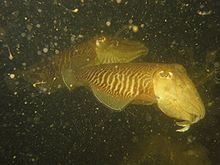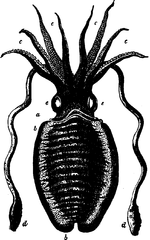- Common Cuttlefish
-
This article is about the European common cuttlefish. For the South African common cuttlefish, see Sepia vermiculata.
Common Cuttlefish 
Sepia officinalis Scientific classification Kingdom: Animalia Phylum: Mollusca Class: Cephalopoda Order: Sepiida Family: Sepiidae Genus: Sepia Subgenus: Sepia Species: S. officinalis Binomial name Sepia officinalis
Linnaeus, 1758Synonyms - Sepia rugosa
Bowdich, 1822 - Sepia vicellius
Gray, 1849 - Sepia zebrina
Risso, 1854 - Sepia filliouxi
Lafont, 1869 - ?Sepia fischeri
Lafont, 1871 - Sepia officinalis mediterranea
Ninni, 1884 - ?Sepia veranyi
P. Fischer in Lagatu, 1888
The Common Cuttlefish or European Common Cuttlefish (Sepia officinalis) is one of the largest and best known cuttlefish species. It grows to 49 cm in mantle length (ML) and 4 kg in weight.[1] Animals from subtropical seas are smaller and rarely exceed 30 cm in ML.[2]
The Common Cuttlefish is native to at least the Mediterranean Sea, North Sea, and Baltic Sea, although subspecies have been proposed as far south as South Africa. It lives on sand and mud seabeds to a depth of around 200 m. As in most cuttlefish species, spawning occurs in shallow waters.[3]
Contents
Predators and prey
Known predators of S. officinalis include large fish[4] (such as monkfish and swordfish, Xiphias gladius)[5][6] and whales.[4]
In the wild, S. officinalis is known to prey upon a wide variety of animals. These include: bony fishes, copepods, crustaceans (including Astacus leptodactylus, Carcinus sp., Crangon sp., Daphnia sp., Gammarus sp., Mugil sp., Mysis sp., Penaeus sp., Praunus sp., Sphaeroma sp., Squilla sp.), decapod cephalopods, gastropods, lamellibranches, nemerteans, octopods, ostracods, polychaetes, and pteropods.[7]
A 2008 study on S. officinalis[8] revealed that cuttlefish embryos, if visually exposed to a certain species of prey (e.g. crabs), will hunt primarily for that prey in later life. S. officinalis usually prefer shrimp to crabs, but when the embryos were exposed to crabs and the embryos had hatched, the young cuttlefish switched preferences and proceeded to hunt the crabs more often than the shrimp.[9]
Taxonomy
It is unknown where the type specimen of S. officinalis was collected, as the location is given simply as "Oceano". It is deposited in the Linnean Society of London.[10]
Sepia officinalis jurujubai Oliveira, 1940, originally described as a subspecies of the Common Cuttlefish, is a junior synonym of Sepioteuthis sepioidea.[11]
See also
References
- ^ Reid, A., P. Jereb, & C.F.E. Roper 2005. Family Sepiidae. In: P. Jereb & C.F.E. Roper, eds. Cephalopods of the world. An annotated and illustrated catalogue of species known to date. Volume 1. Chambered nautiluses and sepioids (Nautilidae, Sepiidae, Sepiolidae, Sepiadariidae, Idiosepiidae and Spirulidae). FAO Species Catalogue for Fishery Purposes. No. 4, Vol. 1. Rome, FAO. pp. 57–152.
- ^ Roper C.F.E., M.J. Sweeney & C.E. Nauen 1984. Cephalopods of the world. Food and Agriculture Organization, Rome, Italy. Vol. 3, p. 277.
- ^ Norman, M.D. 2000. Cephalopods: A World Guide. ConchBooks.
- ^ a b Le-Mao, P. 1985. Place de la seiche Sepia officinalis (mollusque, Cephalopoda) dans les chaines alimentaires du golfe Normano-Breton. Cah. Biol. Mar. 26(3): 331-340.
- ^ Hernández-Garcia, V. 1995. The diet of the swordfish Xiphias gladius Linnaeus, 1758, in the central east Atlantic, with emphasis on the role of cephalopods. Fishery Bulletin 93: 403-411.
- ^ Royer, J., M.B. Santos, S.K. Cho, G. Stowasser, G.J. Pierce, H.I. Daly & J.-P. Robin. 1998. Cephalopod consumption by fish in English Channel and Scottish waters. International Council for the Exploration of the Sea: The impact of Cephalopods in the Food Chain and Their Interaction with the Environment, CM/M: 23.
- ^ Boletzky S.v. & R.T. Hanlon. 1983. A Review of the Laboratory Maintenance, Rearing and Culture of Cephalopod Molluscs. Memoirs of the National Museum of Victoria: Proceedings of the Workshop on the Biology and Resource Potential of Cephalopods, Melbourne, Australia, 9–13 March 1981, Roper, Clyde F.E., C.C. Lu &F.G. Hochberg, ed. 44: 147-187.
- ^ Anne-Sophie Darmaillacq, Clemence Lesimple, and Ludovic Dickel. 2008. Embryonic visual learning in the cuttlefish, Sepia officinalis. Animal Behaviour 76: 131–134
- ^ Walker, M. 2008. Cuttlefish spot target prey early. BBC News, June 5, 2008.
- ^ Current Classification of Recent Cephalopoda
- ^ Adam, W. & W.J. Rees. 1966. A Review of the Cephalopod Family Sepiidae. John Murray Expedition 1933-34, Scientific Reports 11(1): 1-165, 46 plates.
- Taxa Associated with the Family Sepiidae Keferstein, 1866
- Fluckiger, M., G.D. Jackson, P. Nichols, P. Virtue, A. Daw & S. Wotherspoon. 2008. An experimental study of the effect of diet on the fatty acid profiles of the European Cuttlefish (Sepia officinalis). Marine Biology (published online first). doi:10.1007/s00227-008-0932-0
External links
Categories:- Cuttlefish
- British Isles coastal fauna
- Animals described in 1758
- Sepia rugosa
Wikimedia Foundation. 2010.


